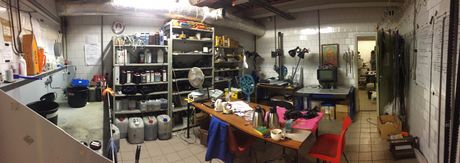Thematic Do-It-Yourself Film (2017-2018)
Do-It-Yourself Attitude As Strategy For Innovation, lead by Esther Urlus, Filmwerkplaats, WORM.
In the world of contemporary celluloid practice a "model of self-skilling," is now necessary for the continuation of photochemical filmmaking among future generations of artists. While the film industry collapses all around us, this Do-It-Yourself attitude gives a chance to reinvent the medium in an image that was neither intended nor desired by its commercial exploiters.
Although film is now largely considered insignificant and ill-suited to a modern society of efficiency, instantaneity, and convenience, its cumbersome machinery, awkward manual interventions, and time-consuming processes nonetheless remain a desirable form of image-making among large numbers of contemporary artists.
We are now at a time that alternative infrastructures and practices allow artists to control and reinvent every stage of the once-industrial process of production. The new sense of freedom and liberation to which this shift has given rise reframes film as a field of discovery, a photochemical playground that offers itself to the artist in the rawness and malleable nature of its physicality. It is this fascination with materials that increasingly characterizes celluloid film culture, particularly through engagements with the past as a means of reinvention and projection towards a potential future.
Part 1: Frugal Filmmaking: minimal resources and little specialist knowledge
Day one: Wednesday 03 April, 10.00-17.00, Filmwerkplaats, WORM
A hands-on introduction into the world of modern Do-It-Yourself filmmaking and its distinctive appearance.
incl. Film as photochemical playground, the paintable nature of its physicality and we will explore the areas between the image area and the soundtrack on the film strip, between light projection and sound reproduction.
Day two: Thursday 04 April, 10.00-17.00, Filmwerkplaats, WORM
Structural Materialism: The process of the film's making deals with devices that result in the demystification of the film process. Do the tools we use form our consciousness and affect our artistic practice?
Part 2: Politics of resistance: what does a post-film, filmmaker environment look like today
Day three: Thursday 11 April, 10.00-17.00, Filmwerkplaats, WORM
DIY in approach and anarchistic in spirit, this ever-expanding community represents a politics of resistance, a devoted and forceful opposition to the capitalist narrative of progress. Analogue (or photochemical) film practice in the context of obsolescence, addressing the specific relationship between past, present and future that it activates.
DIY in approach and anarchistic in spirit, this ever-expanding community represents, I argue, a politics of resistance, a devoted and forceful opposition to the capitalist narrative of progress. In this paper, I’ll discuss analogue (or photochemical) film practice in the context of obsolescence, addressing the specific relationship between past, present and future that it activates. The presentation will also consider the kinds of materialist practices that have emerged in the past decades, and will suggest some new theoretical paradigms for understanding work that is rooted in the past, responds to the present, and projects into potential futures.
(Kim Kowles).
Esther Urlus (NL) is a Rotterdam-based artist working with motion picture film formats Super8, 16mm and 35mm. Resulting in films, performances and installations, her works always arise from DIY methods. Kneading the material, by trial, error and (re) inventing, she creates new work. Her work has been exhibited and screened at film festivals worldwide, among other Oberhausen Short Film Festival, Sonic Acts, and the International Film Festival Rotterdam. Urlus is the founder of WORM Filmwerkplaats.
The Filmwerkplaats at WORM, Rotterdam is the only artist-run film lab in the Netherlands and is known worldwide as one of the largest, most technically advanced and most active communities lab for handmade, analog experimental film. Known artists like Luke Fowler have here learned their 16mm film craft, and established filmmakers now use it as their facility. The movement of artist film labs is one of the most notable trends in contemporary arts. Now that celluloid film as a medium in the commercial film world is almost gone, it is now by artists still maintained and used experimentally because of its stunning visual and material qualities.

